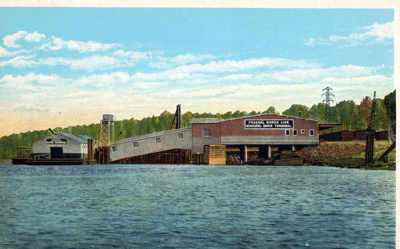Encyclopedia Dubuque
"Encyclopedia Dubuque is the online authority for all things Dubuque, written by the people who know the city best.”
Marshall Cohen—researcher and producer, CNN
Affiliated with the Local History Network of the State Historical Society of Iowa, and the Iowa Museum Association.
FEDERAL BARGE LINE: Difference between revisions
No edit summary |
No edit summary |
||
| Line 28: | Line 28: | ||
Telegraph Herald | Telegraph Herald | ||
Kruse, Len. ''My Old Dubuque''. | Kruse, Len. "The Federal Barge Line," ''My Old Dubuque''. Center for Dubuque History, Loras College, Dubuque, Iowa 2000 p. 232-236 | ||
Revision as of 21:39, 19 June 2012
FEDERAL BARGE LINE. The Transportation Act of 1920 passed by Congress established the Inland Waterways Corporation in 1924. The Upper Mississippi Division representing twenty-one communities in Iowa, Illinois, Wisconsin and Minnesota inaugurated the Federal Barge Line Service between St. Louis and Minneapolis in 1927. The Act required freight to be balanced and in bulk. The government would continue in operations long enough to demonstrate water transportation possibilities and attract private enterprise. The government was already operating a barge line between St. Louis and the Gulf of Mexico. The Federal Barge Line opened the possibilities for transportation north from St. Louis.
On October 13, 1926, W.W. Morse, vice president and general manager of the Upper Mississippi Barge Line headquartered in Minneapolis, Minnesota, met with members of the Dubuque Chamber of Commerce. Morse explained that shippers in Minneapolis and St. Paul were interested in river traffic. Between 1920 and 1926, the cost of car lot shipments had increased 200 percent in some instances. The Minneapolis businessmen believed the use of the river would free the area from the freight rates handicapping agriculture, manufacturing and business.
Conditions were studied and then it was decided to form a corporation to construct and operate a barge line on the upper MISSISSIPPI RIVER. Minneapolis contributed $72,000, St. Paul $48,000, Dubuque $5,000 with other cities along the river contributing various amounts. Finally a contract was written with the federal government's Inland Waterways Corporation. The DUBUQUE BOAT AND BOILER WORKS received the contract to build three tow boats.
Morse went on to suggest that Dubuque was the logical terminal as a transfer point for shipments going to and from Chicago and the Twin Cities and that a great amount of rail and water traffic for shippers from the area west of Dubuque would be routed by way of the city. The problem in Dubuque was that the government required a satisfactory terminal. Dubuque had no dock or loading ramp for barges and problems at the levee made unloading difficult.
On October 14, 1926, the Dubuque City Council took official action authorizing a special city election on the the day of the general election that year, November 2, on the following question:
Shall the city council of the City of Dubuque
be authorized to create a department to be known
as the department of public docks?
The city council also authorized representatives of the city to accompany representatives of the Chamber of Commerce, the Dubuque Shippers' Association and the press of the city on a trip of the lower Mississippi River to inspect terminals and barge line activities in St. Louis and New Orleans. This tour began on October 16, 1926.
The members of the touring committee found various terminals along the river busy with commerce. They were also told that population growth in the thousands could be expected for a city located at a terminal.
Th election results showed support for the proposal in every one of the fifteen precincts. The total vote was 6,732 to 2,970. The city council quickly named John A. KERPER and P.S. Fawkes, two of the people who had been involved in the tour, and Louis Brede, a former city commissioner, to the first dock commission. This commission determined the kind of terminal to be erected and directed the work to completion. C.J. Hoffman,and L.E. Moore were the first terminal superintendent and chief clerk respectively.
When the terminal was completed from two to six barges could be unloaded at one time. Two tow motors, hauling from one to five five of the 30 two-ton loading and unloading trucks were used for the lighter loads. Heavier freight was moved by an eighteen-ton crane and a specially designed runway south of the terminal.
---
Source:
Telegraph Herald
Kruse, Len. "The Federal Barge Line," My Old Dubuque. Center for Dubuque History, Loras College, Dubuque, Iowa 2000 p. 232-236


